Sandia uses a variety of in-situ process diagnostics to investigate, monitor, and sometimes control metal AM processes. The resulting data are used to validate computational models, improve fundamental process understanding, and detect process disruption.
Click on one of the tabs to learn more:
Thermal Imaging
Sandia uses a variety of diagnostics to improve understanding of metal additive processes. In the examples shown here, thermal imaging is used to investigate both Laser Engineered Net Shaping (LENS) and Laser Powder Bed metal AM.
LENS
Video of the LENS metal AM process captured with a FLIR® thermal imaging system.
These thermal imaging videos illustrate two very different thermal histories with the simple change from a unidirectional LENS build to a bidirectional build, ultimately resulting in different microstructures and properties.
Thermal image of a bi-directional build
Thermal image of a uni-directional build

Laser Powder Bed
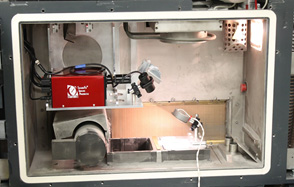
Stratonics ThermaViz® system installed in a 3D Systems ProX200 Laser Powder Bed machine.
FLIR thermal image video taken during a single build layer with 316L stainless steel in a 3D Systems ProX200 machine.
Process Monitoring
Thermal imaging can also be used for process monitoring. For example, to investigate defect detection with thermal signatures, Sandia built a sample (left) with intentional void regions of various sizes ranging from 30 microns to 300 microns. Void defects (dark blue squares) as small as 60 microns could be identified in thermal images from successive build layers (right).
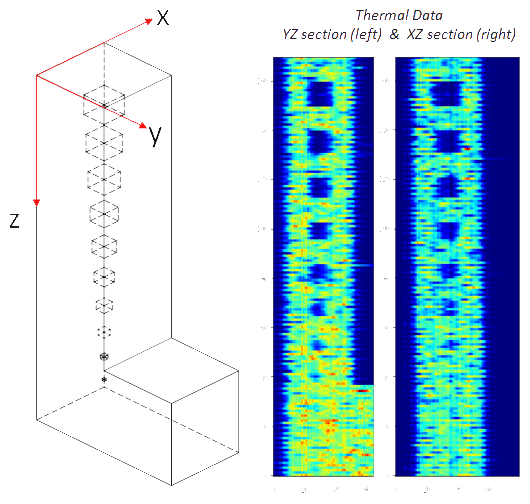
Process Mapping
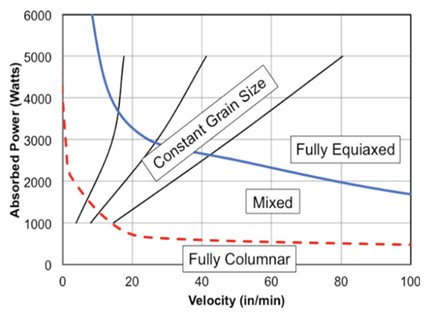
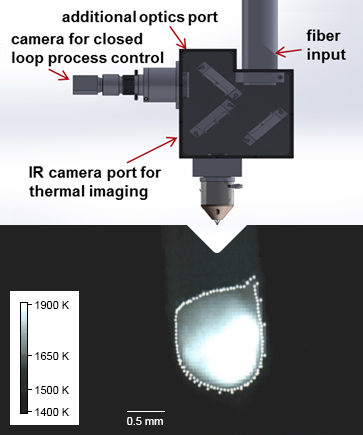
Large-scale Atomic / Molecular Massively Parallel Simulator (LAMMPS)
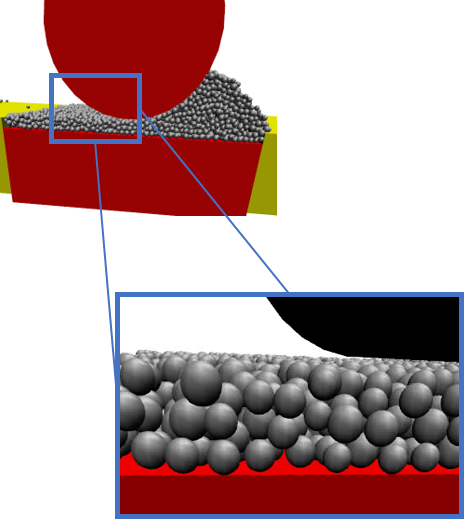
High-performance computing simulations using the Sandia-developed LAMMPS code capture powder dynamics at the scale of individual powder particles. These simulations provide researchers detailed insights into the connections between powder feedstock properties, powder spreading parameters and powder bed quality, which is the first process step in many powder fusion AM technologies.
Particle-scale AM Models
Particle-scale AM models have been developed at Sandia that resolve the process at the scale of the individual powder particles and laser spot. They model complex multi-physics including melting and solidification, multi-phase fluid flow, and heat transfer. These models provide insight into the detailed physical processes that drive a part build and can be used as a baseline to inform larger scale models.
SIERRA Aria and Solid Mechanics
New methodologies have been implemented utilizing SIERRA Aria and Solid Mechanics to enable thermal mechanical part-scale simulations of additive manufacturing processes. By tracking the surface topology changes for radiation and convection, this methodology provides a detailed thermal history throughout the build. Detailed thermal histories are then used to inform the solid mechanics simulations, which are capable of predicting the evolution of residual stresses and microstructure within a part. This methodology can in turn lead to optimization of process parameters and performance certification.
Distortion and Residual Stress
Models of full parts allow researchers to quickly examine AM effects such as distortion and residual stress. The resulting parts are also being utilized in subsequent simulations such as machining to predict properties of the as-built part and fully capture the manufacturing and loading histories.